Abstract
Embryo survival and transgene integration rates are two major factors that influence the efficiency of transgenic animal production by pronuclear microinjection. Recombinase A protein-coated transgenes were compared for transgene integration and embryo survival with their non-coated counterparts in both single- and double-stranded forms. Murine zygotes were microinjected with a large 30 kb αS1-casein/human lysozyme DNA construct and a small 5.5 kb β-lactoglobulin/desaturase DNA construct using four different construct preparations for each gene. The preparations included recombinase A protein-coated, single- and double-stranded DNA constructs and non-coated, single- and double-stranded DNA constructs. Using conventional non-coated, double-stranded DNA constructs, we obtained a transgene integration efficiency of 1.5% (1352 embryos transferred produced 20 transgenic pups). The same double-stranded DNA constructs coated with recombinase A protein yielded a similar percentage of transgene integration (1.1%, 18/1697). Using single-stranded DNA, non-coated constructs produced a transgene integration rate of 0.5%, while none of the 1040 zygotes injected with recombinase A-coated constructs produced transgenic pups. While recombinase A protein coating produced no effect on embryo survival, litter size or pregnancy rate with double-stranded constructs, a detrimental effect was observed on embryo survival (P < 0.001) and pregnancy rate (P < 0.005) with recombinase A protein coating of single-stranded human lysozyme DNA constructs. A trend toward increased embryo survival (P = 0.054) with no difference in pregnancy rate (P > 0.05) was observed with the recombinase A protein coating of single-stranded desaturase constructs. These results suggest that recombinase A protein coating of single- and double-stranded DNA constructs produced no significant differences (P > 0.05) in the efficiency of generating transgenic mice with respect to the percentage of transgenic animals born.
Similar content being viewed by others
References
Behboodi E, Anderson GB, Horvat S, Medrano JF, Murray JD, Rowe JD (1993) Microinjection of bovine embryos with a foreign gene and its detection at the blastocyst stage. J Dairy Sci 76:3392–3399
Brinster RL, Chen HY, Trumbauer ME, Yagle MK, Palmiter RD (1985) Factors affecting the efficiency of introducing foreign DNA into mice by microinjecting eggs. Proc Natl Acad Sci USA 82:4438–4442
Dickie P (1995) Evaluating birth frequencies and embryonic lethality in transgenesis following pronuclear injection of HIV DNA. J Biomed Sci 2:146–153
Ebert KM, Schindler JES (1993) Transgenic farm animals: progress report. Theriogenology 39:121–135
Eyestone WH, Gowallis M, Monohan J, Sink T, Ball SF, Cooper JD (1998) Production of transgenic cattle expressing human alpha-lactalbumin in milk. Theriogenology 49:386
Gundersen K, Hanley TA, Merlie JP (1993) Transgenic embryo yield is increased by a simple, inexpensive micropipet treatment. Biotechniques 14:412–414
Hogan B, Beddington R, Costantini F, Lacy E (1994) Manipulating the mouse embryo. In: Hogan B, Beddington R, Costantini F, Lacy E (eds) Manipulating the mouse embryo: a laboratory manual, 2nd edn. Cold Spring Harbor Laboratory Press, Plainview, NY pp 130–226
Huang L-C, Clarkin KC, Wahl GM (1996) Sensitivity and selectivity of the DNA damage sensor responsible for activating p53-dependent G1 arrest. Proc Natl Acad Sci 93:4827–4832
Kaneko T, Moisyadi S, Suganuma R, Hohn B, Yanagimachi R, Pelczar P (2005) Recombinase-mediated mouse transgenesis by intracytoplasmic sperm injection. Theriogenology 64:1704–1715
Kupriyanov S, Zeh K, Baribault H (1998) Double pronuclei injection of DNA into zygotes increases yields of transgenic mouse lines. Transgenic Res 7:223–226
Maga EA, Anderson GB, Huang MC, Murray JD (1994) Expression of human lysozyme mRNA in the mammary gland of transgenic mice. Transgenic Res. 3:36–42
Maga EA, Sargent RG, Zeng H, Pati S, Zarling DA, Oppenheim SM, Collette NM, Moyer AL, Conrad-Brink JS, Rowe JD, BonDurant RH, Anderson GB, Murray JD (2003) Increased efficiency of transgenic livestock production. Transgenic Res 12:485–496
Pursel VG, Pinkert CA, Miller KF, Bolt DJ, Campbell RG, Palmiter RD, Brinster RL, Hammer RE (1989) Genetic engineering of livestock. Science 244:1281–1288
Reh WA, Maga EA, Collette NM, Moyer A, Conrad-Brink JS, Taylor SJ, DePeters EJ, Oppenheim S, Rowe JD, BonDurant RH, Anderson GB, Murray JD (2004) Hot topic: using a stearoyl-CoA desaturase transgene to alter milk fatty acid composition. J Dairy Sci 87:3510–3514
Wall RJ, Paleyanda RK, Foster JA, Powell A, Rexroad C, Lubon H (2000) DNA preparation method can influence outcome of transgenic animal experiments. Anim Biotechnol 11:19–32
Wall RJ (2002) New gene transfer methods. Theirogenology 57:189–201
Zaitseva EM, Zaitsev EN, Kowalczykowski SC (1999) The DNA binding properties of Saccharomyces cerevisiae Rad51 protein. J Biol Chem 274:2907–2915
Acknowledgements
We thank Dr. Thomas Famula and Janice Conrad-Brink for their intellectual and technical support and Alice Moyer, Nicole Collette and Sandra Wiesker for their technical assistance. JBM was supported by an NIH IMSD Award (R25GM56765).
Author information
Authors and Affiliations
Corresponding author
Rights and permissions
About this article
Cite this article
Mason, J.B., Najarian, J.G., Anderson, G.B. et al. The effect of coating single- and double-stranded DNA with the recombinase A protein of Escherichia coli on transgene integration in mice. Transgenic Res 15, 703–710 (2006). https://doi.org/10.1007/s11248-006-9005-7
Received:
Accepted:
Published:
Issue Date:
DOI: https://doi.org/10.1007/s11248-006-9005-7




